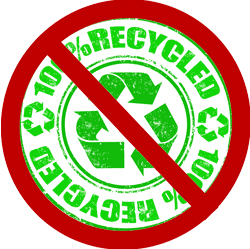 “Today, paper is the most recycled material on the planet,” explains this post from the Domtar Newsroom,” and despite already reaching record high levels, the push is on to reach the maximum practical paper recovery rate of 80 percent.
“Today, paper is the most recycled material on the planet,” explains this post from the Domtar Newsroom,” and despite already reaching record high levels, the push is on to reach the maximum practical paper recovery rate of 80 percent.
Why not 100%? According to the article, that figure is just not possible due to the way recycled paper is processed.
“The wear and tear caused by the various recycling processes — collection, deinking, remanufacturing — lowers the yields of each successive round of recycling,” the article notes, explaining that paper can typically only be recycled five to seven times before the fibers are too degraded to be remade into something new. Still other paper – like that used for dog bedding or food wrapping – are not sanitary and can’t be recycled.
Interestingly, new methods to recycle more of our household waste are actually hampering more complete paper recycling. As the article notes, “the move to single-stream collection — where plastics, papers and glass are collected in a single truck for convenience — has resulted in dramatically reduced fiber quality. Employees at sorting facilities must manually remove unrecyclable items from the recycling line, which is a costly endeavor. Too often, these non-recyclable items (such as plastic grocery bags, diapers and dirty food containers) get missed, rendering batches of recycled content unusable.”
Challenges aside, recycling is a great thing, and we encourage our customers to use recycled paper in their printing projects when it’s appropriate. Still, we realize that in the paper industry, we’ll never see 100% recycling. The simple fact is this: there exists a symbiotic relationship between paper harvesting and recycling, with fresh wood pulp being needed to infuse the recycled paper fibers with strength. Without fresh wood, the supply of recycled paper will run out in short order.
That’s where sustainable forestry comes in, a concept that not only supports the recycled paper industry but has positive environmental impacts in other areas. And thanks to these forestry efforts, U.S. forests grew by 5,800 football fields per day between 2007 and 2012. That’s a huge amount of new trees, thanks, in part, to an environmentally sensitive paper industry.
Even if we could reach 100% recycling, we wouldn’t want to. The paper industry as a whole has been very, very good for our trees, saving land from development and deforestation.
